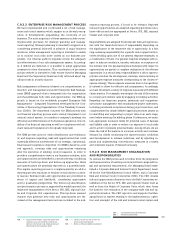Siemens 2012 Annual Report Download - page 210
Download and view the complete annual report
Please find page 210 of the 2012 Siemens annual report below. You can navigate through the pages in the report by either clicking on the pages listed below, or by using the keyword search tool below to find specific information within the annual report.
1 A. To our Shareholders
21 B. Corporate Governance 49 C. Combined Management Report
50 C. Business and economic environment
64 C. Financial performance measures
69 C. Results of operations
82 C. Financial position
93 C. Net assets position
95 C. Overall assessment of the economic position
96 C. Subsequent events
97 C. Sustainability
111 C. Report on expected developments and
associated material opportunities and risks
between our products, solutions and services depending on
the degree of information technology utilized. However, we al-
so believe that this trend needs to be monitored closely, be-
cause it might bear the potential to change the competitive
landscape. Any inability to adapt to the factors aforementioned
could have a material adverse effect on our business, financial
condition and results of operations.
Our business, financial condition and results of opera-
tions may be adversely affected by continued strategic
alignments and cost-cutting initiatives: We are in a con-
tinuous process of strategic alignments and constantly engage
in cost-cutting initiatives, including in connection with ongo-
ing capacity adjustment measures and structural initiatives.
Capacity adjustments through consolidation of business activi-
ties and manufacturing facilities, and the streamlining of prod-
uct portfolios are also part of these cost reduction efforts.
These measures may not be implemented as planned, may
turn out to be less effective than anticipated, may only become
effective later than estimated or may not become effective at
all. Each of these factors alone or in combination may nega-
tively impact our business, financial condition, and results of
operations. Any future contribution of these measures to our
profitability will be influenced by the actual savings achieved
and by our ability to sustain these ongoing efforts.
Our business, financial condition and results of opera-
tions may be adversely affected by portfolio measures:
Our strategy includes divesting activities in some business
areas and strengthening others through portfolio measures,
including mergers and acquisitions.
With respect to dispositions, we may not be able to divest some
of our activities as planned, and the divestitures we do carry out
could have a negative impact on our business, financial condi-
tion, results of operations and, potentially, our reputation. For
example, we have announced to divest OSRAM, our solar busi-
ness and the business activities included in the Industry Sec-
tor’s Water Technologies Business Unit, which as of September
, was part of the Industry Automation Division.
Mergers and acquisitions are inherently risky because of diffi-
culties that may arise when integrating people, operations,
technologies and products. There can be no assurance that
any of the businesses we acquire can be integrated successful-
ly and as timely as originally planned or that they will perform
well once integrated. In addition, we may incur significant ac-
quisition, administrative and other costs in connection with
these transactions, including costs related to integration of
acquired businesses. Furthermore, portfolio measures may
result in additional financing needs and adversely affect our fi-
nancial leverage and our debt-to-equity ratio. Acquisitions may
also lead to substantial increases in intangible assets, includ-
ing goodwill. Our Statements of Financial Position reflects a
significant amount of intangible assets, including goodwill.
Among our businesses, the largest amount of goodwill is allo-
cated to the Diagnostics Division and the Imaging & Therapy
Division of the Healthcare Sector, and the Industry Automation
Division of the Industry Sector. In fiscal , the annual test
for impairment of goodwill of the Diagnostics Division within
the Healthcare Sector was performed as of September ,
. As a result, in the Diagnostics Division of the Healthcare
Sector an impairment of €, million was recognized to re-
duce the carrying amount of goodwill. If we were to encounter
continuing adverse business developments including negative
effects on our revenues, profits or cash, or adverse effects from
an increase in the weighted average cost of capital (WACC) or
from foreign exchange rate developments, or if we were other-
wise to perform worse than expected at acquisition, then
these intangible assets, including goodwill, might have to be
written off, which could materially and adversely affect our
business, financial condition and results of operations. The
likelihood of such adverse business developments increases in
times of difficult or uncertain macroeconomic conditions.
Our business, financial condition and results of opera-
tions may be adversely affected by our equity interests,
other investments and strategic alliances: Our strategy
includes strengthening our business interests through joint
ventures, associated companies and strategic alliances. Cer-
tain of our investments are accounted for using the equity
method, including, among others, NSN, EN and BSH. Further-
more we hold other investments, for example Atos S.A. Any
factors negatively influencing the profitability of our equity
and other investments, including negative effects on reve-
nues, profits or cash, could have an adverse effect on our eq-
uity pick-up related to these equity interests or may result in a
write-off of these investments. In addition, our business, fi-
nancial condition and results of operations could also be ad-
versely affected in connection with loans, guarantees or non-
compliance with financial covenants related to these equity
and other investments. Furthermore, such investments are in-
herently risky as we may not be able to sufficiently influence
corporate governance processes or business decisions taken
by our equity investments, other investments and strategic al-
liances that may have a negative effect on our business. In ad-
dition, joint ventures bear the risk of difficulties that may arise
when integrating people, operations, technologies and prod-
ucts. Strategic alliances may also pose risks for us because we
compete in some business areas with companies with which
we have strategic alliances.
























